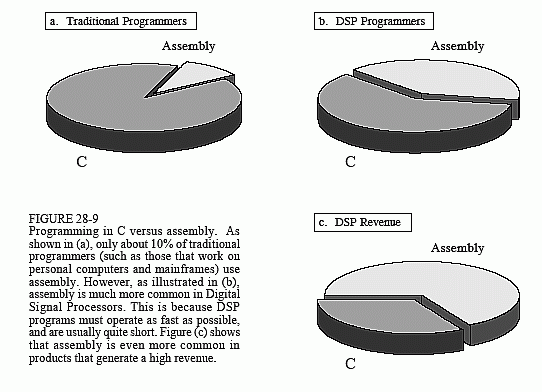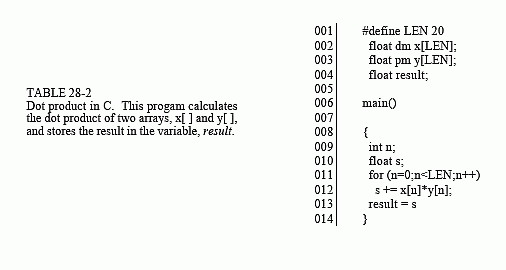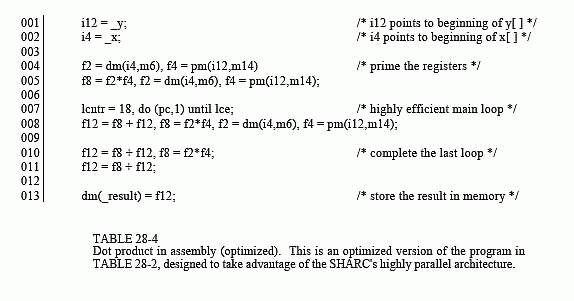The Scientist and Engineer's Guide to
Digital Signal Processing
By Steven W. Smith, Ph.D.
Book Search
Table of contents
- 1: The Breadth and Depth of DSP
- 2: Statistics, Probability and Noise
- 3: ADC and DAC
- 4: DSP Software
- 5: Linear Systems
- 6: Convolution
- 7: Properties of Convolution
- 8: The Discrete Fourier Transform
- 9: Applications of the DFT
- 10: Fourier Transform Properties
- 11: Fourier Transform Pairs
- 12: The Fast Fourier Transform
- 13: Continuous Signal Processing
- 14: Introduction to Digital Filters
- 15: Moving Average Filters
- 16: Windowed-Sinc Filters
- 17: Custom Filters
- 18: FFT Convolution
- 19: Recursive Filters
- 20: Chebyshev Filters
- 21: Filter Comparison
- 22: Audio Processing
- 23: Image Formation & Display
- 24: Linear Image Processing
- 25: Special Imaging Techniques
- 26: Neural Networks (and more!)
- 27: Data Compression
- 28: Digital Signal Processors
- 29: Getting Started with DSPs
- 30: Complex Numbers
- 31: The Complex Fourier Transform
- 32: The Laplace Transform
- 33: The z-Transform
- 34: Explaining Benford's Law
How to order your own hardcover copy
Wouldn't you rather have a bound book instead of 640 loose pages?Your laser printer will thank you!
Order from Amazon.com.
Chapter 28: Digital Signal Processors
DSPs are programmed in the same languages as other scientific and engineering applications, usually assembly or C. Programs written in assembly can execute faster, while programs written in C are easier to develop and maintain. In traditional applications, such as programs run on personal computers and mainframes, C is almost always the first choice. If assembly is used at all, it is restricted to short subroutines that must run with the utmost speed. This is shown graphically in Fig. 28-9a; for every traditional programmer that works in assembly, there are approximately ten that use C.
However, DSP programs are different from traditional software tasks in two important respects. First, the programs are usually much shorter, say, one-hundred lines versus ten-thousand lines. Second, the execution speed is often a critical part of the application. After all, that's why someone uses a DSP in the first place, for its blinding speed. These two factors motivate many software engineers to switch from C to assembly for programming Digital Signal Processors. This is illustrated in (b); nearly as many DSP programmers use assembly as use C.
Figure (c) takes this further by looking at the revenue produced by DSP products. For every dollar made with a DSP programmed in C, two dollars are made with a DSP programmed in assembly. The reason for this is simple; money is made by outperforming the competition. From a pure performance standpoint, such as execution speed and manufacturing cost, assembly almost always has the advantage over C. For instance, C code usually requires a larger memory than assembly, resulting in more expensive hardware. However, the DSP market is continually changing. As the market grows, manufacturers will respond by designing DSPs that are optimized for programming in C. For instance, C is much more efficient when there is a large, general purpose register set and a unified memory space. These future improvements will minimize the difference in execution time between C and assembly, and allow C to be used in more applications.
To better understand this decision between C and assembly, let's look at a typical DSP task programmed in each language. The example we will use is the calculation of the dot product of the two arrays, x[ ] and y[ ]. This is a simple mathematical operation, we multiply each coefficient in one

array by the corresponding coefficient in the other array, and sum the products, i.e. x[0]×y[0] + x[1]×y[1] + x[2]×y[2] + …. This should look very familiar; it is the fundamental operation in an FIR filter. That is, each sample in the output signal is found by multiplying stored samples from the input signal (in one array) by the filter coefficients (in the other array), and summing the products.
Table 28-2 shows how the dot product is calculated in a C program. In lines 001-004 we define the two arrays, x[ ] and y[ ], to be 20 elements long. We also define result, the variable that holds the calculated dot

product at the completion of the program. Line 011 controls the 20 loops needed for the calculation, using the variable n as a loop counter. The only statement within the loop is line 012, which multiplies the corresponding coefficients from the two arrays, and adds the product to the accumulator variable, s. (If you are not familiar with C, the statement: s += x[n] * y[n] means the same as: s = s + x[n] * y[n]). After the loop, the value in the accumulator, s, is transferred to the output variable, result, in line 013.
A key advantage of using a high-level language (such as C, Fortran, or Basic) is that the programmer does not need to understand the architecture of the microprocessor being used; knowledge of the architecture is left to the compiler. For instance, this short C program uses several variables: n, s, result, plus the arrays: x[ ] and y[ ]. All of these variables must be assigned a "home" in hardware to keep track of their value. Depending on the microprocessor, these storage locations can be the general purpose data registers, locations in the main memory, or special registers dedicated to particular functions. However, the person writing a high-level program knows little or nothing about this memory management; this task has been delegated to the software engineer who wrote the compiler. The problem is, these two people have never met; they only communicate through a set of predefined rules. High-level languages are easier than assembly because you give half the work to someone else. However, they are less efficient because you aren't quite sure how the delegated work is being carried out.
In comparison, Table 28-3 shows the dot product program written in assembly for the SHARC DSP. The assembly language for the Analog Devices DSPs (both their 16 bit fixed-point and 32 bit SHARC devices) are known for their simple algebraic-like syntax. While we won't go through all the details, here is the general operation. Notice that everything relates to hardware; there are no abstract variables in this code, only data registers and memory locations.
Each semicolon represents a clock cycle. The arrays x[ ] and y[ ] are held in circular buffers in the main memory. In lines 001 and 002, registers i4


and i12 are pointed to the starting locations of these arrays. Next, we execute 20 loop cycles, as controlled by line 004. The format for this statement takes advantage of the SHARC DSP's zero-overhead looping capability. In other words, all of the variables needed to control the loop are held in dedicated hardware registers that operate in parallel with the other operations going on inside the microprocessor. In this case, the register: lcntr (loop counter) is loaded with an initial value of 20, and decrements each time the loop is executed. The loop is terminated when lcntr reaches a value of zero (indicated by the statement: lce, for "loop counter expired"). The loop encompasses lines 004 to 008, as controlled by the statement (pc,4). That is, the loop ends four lines after the current program counter.
Inside the loop, line 005 loads the value from x[ ] into data register f2, while line 006 loads the value from y[ ] into data register f4. The symbols "dm" and "pm" indicate that the values are fetched over the "data memory" bus and "program memory" bus, respectively. The variables: i4, m6, i12, and m14 are registers in the data address generators that manage the circular buffers holding x[ ] and y[ ]. The two values in f2 and f4 are multiplied in line 007, and the product stored in data register f8. In line 008, the product in f8 is added to the accumulator, data register f12. After the loop is completed, the accumulator in f12 is transferred to memory.
This program correctly calculates the dot product, but it does not take advantage of the SHARC highly parallel architecture. Table 28-4 shows this program rewritten in a highly optimized form, with many operations being carried out in parallel. First notice that line 007 only executes 18 loops, rather than 20. Also notice that this loop only contains a single line (008), but that this line contains multiple instructions. The strategy is to make the loop as efficient as possible, in this case, a single line that can be executed in a single clock cycle. To do this, we need to have a small amount of code to "prime" the registers on the first loop (lines 004 and 005), and another small section of code to finish the last loop (lines 010 and 011).
To understand how this works, study line 008, the only statement inside the loop. In this single statement, four operations are being carried out in parallel: (1) the value for x[ ] is moved from a circular buffer in program memory and placed in f2; (2) the value for y[ ] is being moved from a circular buffer in data memory and placed in f4; (3) the previous values of f2 and f4 are multiplied and placed in f8; and (4) the previous value in f8 is added to the accumulator in f12.
For example, the fifth time that line 008 is executed, x[7] and y[7] are fetched from memory and stored in f2 and f4. At the same time, the values for x[6] and y[6] (that were in f2 and f4 at the start of this cycle) are multiplied and placed in f8. In addition, the value of x[5] × y[5] (that was in f8 at the start of this cycle) is added to the value of f12.
Let's compare the number of clock cycles required by the unoptimized and the optimized programs. Keep in mind that there are 20 loops, with four actions being required in each loop. The unoptimized program requires 80 clock cycles to carry out the actions within the loops, plus 5 clock cycles of overhead, for a total of 85 clock cycles. In comparison, the optimized program conducts 18 loops in 18 clock cycles, but requires 11 clock cycles of overhead to prime the registers and complete the last loop. This results in a total execution time of 29 clock cycles, or about three times faster than the brute force method.
Here is the big question: How fast does the C program execute relative to the assembly code? When the program in Table 28-2 is compiled, does the executable code resemble our efficient or inefficient assembly example? The answer is that the compiler generates the efficient code. However, it is important to realize that the dot product is a very simple example. The compiler has a much more difficult time producing optimized code when the program becomes more complicated, such as multiple nested loops and erratic jumps to subroutines. If you are doing something straightforward, expect the compiler to provide you a nearly optimal solution. If you are doing something strange or complicated, expect that an assembly program will execute significantly faster than one written in C. In the worst case, think a factor of 2-3. As previously mentioned, the efficiency of C versus assembly depends greatly on the particular DSP being used. Floating point architectures can generally be programmed more efficiently than fixed-point devices when using high-level languages such as C. Of course, the proper software tools are important for this, such as a debugger with profiling features that help you understand how long different code segments take to execute.
There is also a way you can get the best of both worlds: write the program in C, but use assembly for the critical sections that must execute quickly. This is one reason that C is so popular in science and engineering. It operates as a high-level language, but also allows you to directly manipulate

the hardware if you so desire. Even if you intend to program only in C, you will probably need some knowledge of the architecture of the DSP and the assembly instruction set. For instance, look back at lines 002 and 003 in Table 28-2, the dot product program in C. The "dm" means that x[ ] is to be stored in data memory, while the "pm" indicates that y[ ] will reside in program memory. Even though the program is written in a high level language, a basic knowledge of the hardware is still required to get the best performance from the device.
Which language is best for your application? It depends on what is more important to you. If you need flexibility and fast development, choose C. On the other hand, use assembly if you need the best possible performance. As illustrated in Fig. 28-10, this is a tradeoff you are forced to make. Here are some things you should consider.
- How complicated is the program? If it is large and intricate, you will probably want to use C. If it is small and simple, assembly may be a good choice.
- Are you pushing the maximum speed of the DSP? If so, assembly will give you the last drop of performance from the device. For less demanding applications, assembly has little advantage, and you should consider using C.
- How many programmers will be working together? If the project is large enough for more than one programmer, lean toward C and use in-line assembly only for time critical segments.
- Which is more important, product cost or development cost? If it is product cost, choose assembly; if it is development cost, choose C.
- What is your background? If you are experienced in assembly (on other microprocessors), choose assembly for your DSP. If your previous work is in C, choose C for your DSP.
- What does the DSP's manufacturer suggest you use?
This last item is very important. Suppose you ask a DSP manufacturer which language to use, and they tell you: "Either C or assembly can be used, but we recommend C." You had better take their advice! What they are really saying is: "Our DSP is so difficult to program in assembly that you will need 6 months of training to use it." On the other hand, some DSPs are easy to program in assembly. For instance, the Analog Devices products are in this category. Just ask their engineers; they are very proud of this.
One of the best ways to make decisions about DSP products and software is to speak with engineers who have used them. Ask the manufacturers for references of companies using their products, or search the web for people you can e-mail. Don't be shy; engineers love to give their opinions on products they have used. They will be flattered that you asked.
